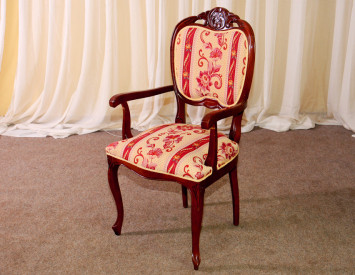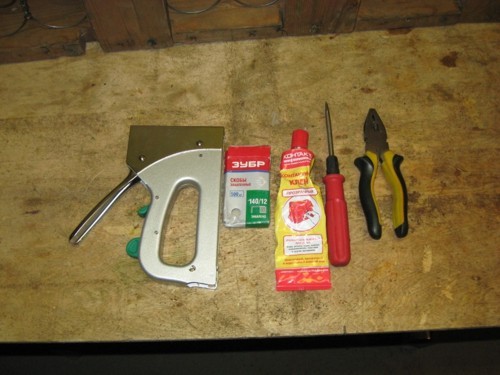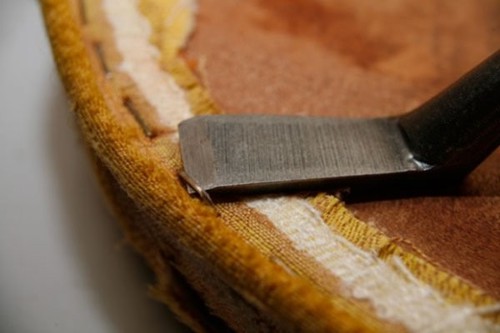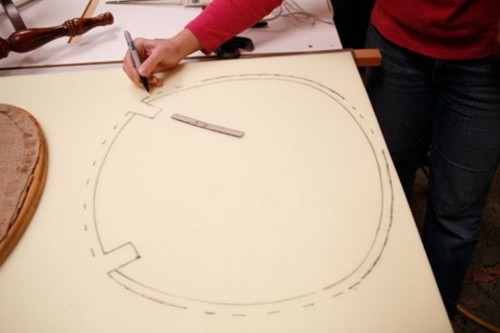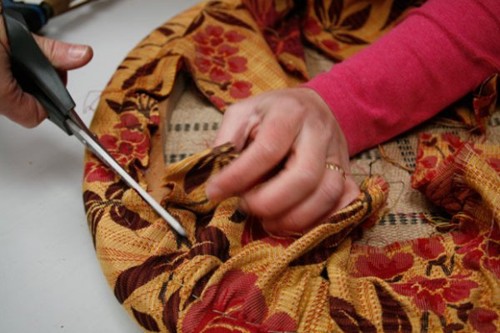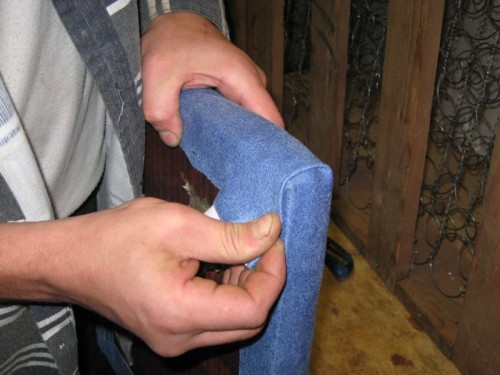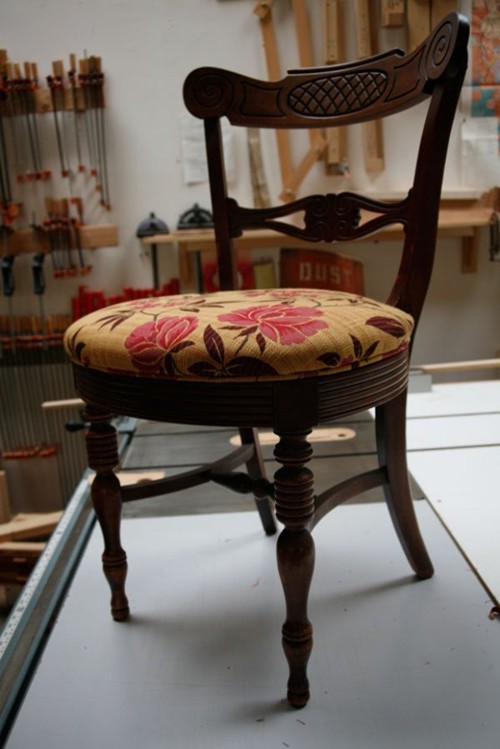No matter how the road is furniture, but over the years it wears out and the time comes when it is no longer possible to use it. The first unusability is upholstery on sofas, chairs and chairs, it not only becomes obsolete, polluted, but also dudges. Due to the unsightly appearance with your favorite soft chairs, you have to part. If your family has ancient furniture, which you inherited, then there is a chance to restore it.
Content
In order to fulfill the chairs, it is necessary to observe the main requirement - to maintain a wooden frame, but the final result will depend on efforts and your desires.
If the chair is not very worn out and the scuffs were formed in some places, then you can disassemble it - remove the back and replace the old fabric with a new, suitable shade. If the frame is severely damaged by brown beetles, then you can restore such a product, but the chair is unlikely to be as strong as before and over time it will still begin to deteriorate and crumble. Carpenters do not advise proceeding with the restoration of furniture damaged by beetles of the weapons. Separate elements can be replaced, but if the chair is badly damaged, it makes no sense to restore it.
In the 60-90 years of the last century, burlap, felt, cotton wool and hay were used as a filler for upholstered furniture. Even now, some furniture plants continue to be used in the production of technology of the 90s, and plant fiber are used as a filler for chairs. For several years of operation, such a natural filler quickly cums, lumps can form in places, as a result of which the upholstery fabric quickly becomes unusable.
How to choose upholstery
When choosing fabric for breaking a chair, keep in mind the following:
- the density of the material - it should keep the shape well and be durable;
- the fabric should be easily erased;
- the ability to treat the surface with a soap solution or clean with a brush.
Popular fabrics:
- jacquard - dense fabric, has good wear resistance, tightening is not formed on it;
- shenill is a popular upholstery for upholstered furniture. The fabric is very dense and durable;
- tapestry - made of cotton, the material can be washed manually or in a washing machine;
- nubuk or artificial leather - material resistant to abrasion;
- velvet, phlock - the fabric is strong, does not burn out;
- the skin “breathes”, but not resistant to mechanical damage (scratches).
How to pull a chair with your own hands
In order for the stool to stick the stools are performed in a short time, think about what materials you need and prepare the appropriate tool in advance.
Tools
List of materials and tools:
- textile. It is best to use furniture fabrics - tapestry, phlock or jacquard for chairs for chairs. They have the strength to abrasion and durable. Before going to the store for fabric, you need to arm yourself with a centimeter and determine the amount of material. Follow the seats of the chair and add 10 cm to each side to the resulting number. This supply will go to the bend, as well as to the height of the upholstery;
- filler. Good recommendations received such a filler as sheet foam (thickness of not more than 40 mm), can also be used as a filler synthetic winterizer, vatin or latex. You can not take bulk materials (buckwheat, polyurethane or silicone balls) as a filler for sitting for a chair), since the load on this part of the chair will be much higher than the load on the pillow. If you use small filler, then after a few weeks of operation it will begin to pour. If foam is selected as a filler, then its density should be from 30 to 50 kg/m 3. If you use the material of a different density, then the foam rubber will remember and sit on such a chair will be uncomfortable;
- dense cardboard to make a pattern;
- glue and brush. It is best to take PVA in a construction store;
- stapler and furniture staples or cheaper option - small cloves and hammer;
- screwdriver;
- pliers;
- roulette and sharp scissors;
- the ruler, pencil, chalk or a piece of soap for marking.
How to remove old fabric
Work must be started with the removal of old upholstery.
How to remove the worn -out fabric correctly:
- First you need to remove the seat. To do this, you need to turn the chair with legs up and in a strictly given sequence (it is advisable to remember the procedure, since then you have to collect the chair back) to disassemble the fasteners. First, pry the fasteners with a screwdriver, then remove the nails, unscrew the screws and remove the metal overlays. The brackets are easy to lift with a screwdriver and pull it out with pliers. If they sewed into disrepair, the brackets can be thrown away, and the rest of the fastener is folded into a separate bag so as not to lose.
- Now it is necessary to check in what condition is the wooden frame of the chair. If it is shaken, then the overturning of the furniture will not solve the main problem, the appearance will be beautiful, but it will be unsafe to sit on a twisted chair. Therefore, it is first necessary to eliminate all cracks in the wood (fill with a colorless sealant or glue PVA glue), put clamps, and it is advisable to compact weakened compounds.
- It was the turn to remove the old upholstery fabric. Put the polyethylene film on the floor or lay the old newspapers. Remove the old fabric and gently remove the entire foam. At this stage of the chairs of chairs with your own hands, you need to decide on the measurements, so do not rush to throw out the worn -out fabric - you can just immediately make a pattern or find the seat at once according to the old model. Put the old canvas on the wrong side of the new furniture fabric and circle the circuit with chalk.
- Now it is necessary to temporarily put aside the fabric and engage in the basis of the seat. Remove the remains of an adhered crushed foam, remove the old glue.
Prepare fabric and foam
Since it will be difficult for a beginner to fulfill the chairs of a chair without a template, we will just take it manufacturing it. You can make a template differently. The first option: Put on a sheet of cardboard sitting from plywood, circle it with a pencil. Now the plywood can be removed, and in our drawing, add 10 cm to the allowances on each side. Cut the template with scissors or a sharp stationery knife. The second option: we will use the finished template and attach the old fabric to the cardboard sheet, we circle the contour with a pencil. This will be our template. Choose a suitable option for yourself and make a seat template.
We have a ready -made stencil - you can find the desired part with a sharp knife from a sheet of foam. By the same principle, we make a template from the fabric: circle along the contour and add another 10 cm on each side (let it be better than a small supply of fabric than it will not be enough). We cut out the part.
If you have chosen a fabric with a pattern, then it is necessary even at the initial stage - the acquisition of fabric, take this moment into account and take material with a margin. Put the fabric with a pattern so that it is in the middle and there are no displacements. If this rule is not observed, then the chair will not look presentable. Now it is necessary to fix the fabric and mark the marking.
In some chairs, instead of ordinary plywood sitting, you can see a frame made of grid or rubber. When the wicker base is normal, then nothing needs to be done, if the material has become unusable, then it must be changed to dense wide rubberized tapes.
How to pull a chair
First, glue the foam to the faner. Foam is glued to PVA glue. On the front (upper) part of the plywood seats, apply a layer of glue with a brush and attach foam rubber. Wait for the glue to grab. Work on the upholstery of the fabric can begin after the glue completely dry.
When the glue dries - check again, whether the foam is well glued - if there are not glued places, it is advisable to fill them with glue and again wait for its complete drying. Then you can fix the upholstery. Put it with the wrong side up, put the seat on top so that the foam is located “face” to the fabric. On each side, turn out the fabric (this is a reserve) on the plywood. Pull the material tightly so that the fabric does not collect in folds. Now take a furniture stapler and shoot the edges of the fabric to the faner. Work sequentially, with a step of no more than 2 cm. Large folds should not form between the brackets. If you see that large folds are formed in places of rounding, and furniture brackets do not hold them, then these places can be strengthened with furniture cloves. Fun cloves with a hammer. Excess fabric after the end of the stool can be cut.
If you pull the square seat of the chair, then at the corners you need to lay the folds and direct them to the center, bend the fabric, and then attach to the faner.
We install the tug seat of the chair back on the frame, first we attach the plates, and then fasten the screws. DIY chair is completed. This is what a restored chair looks like:
How to pull a chair, you can watch this video:
